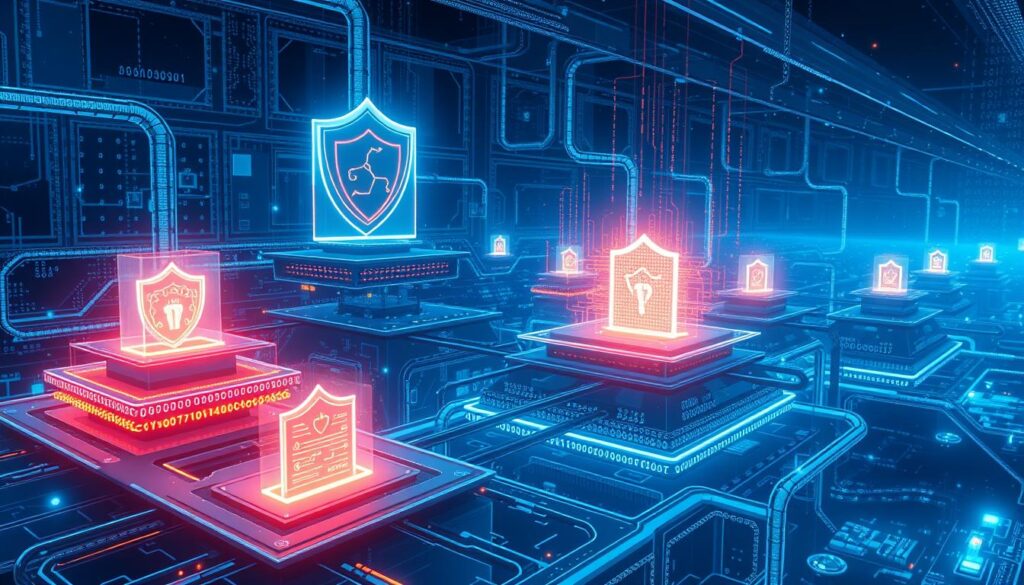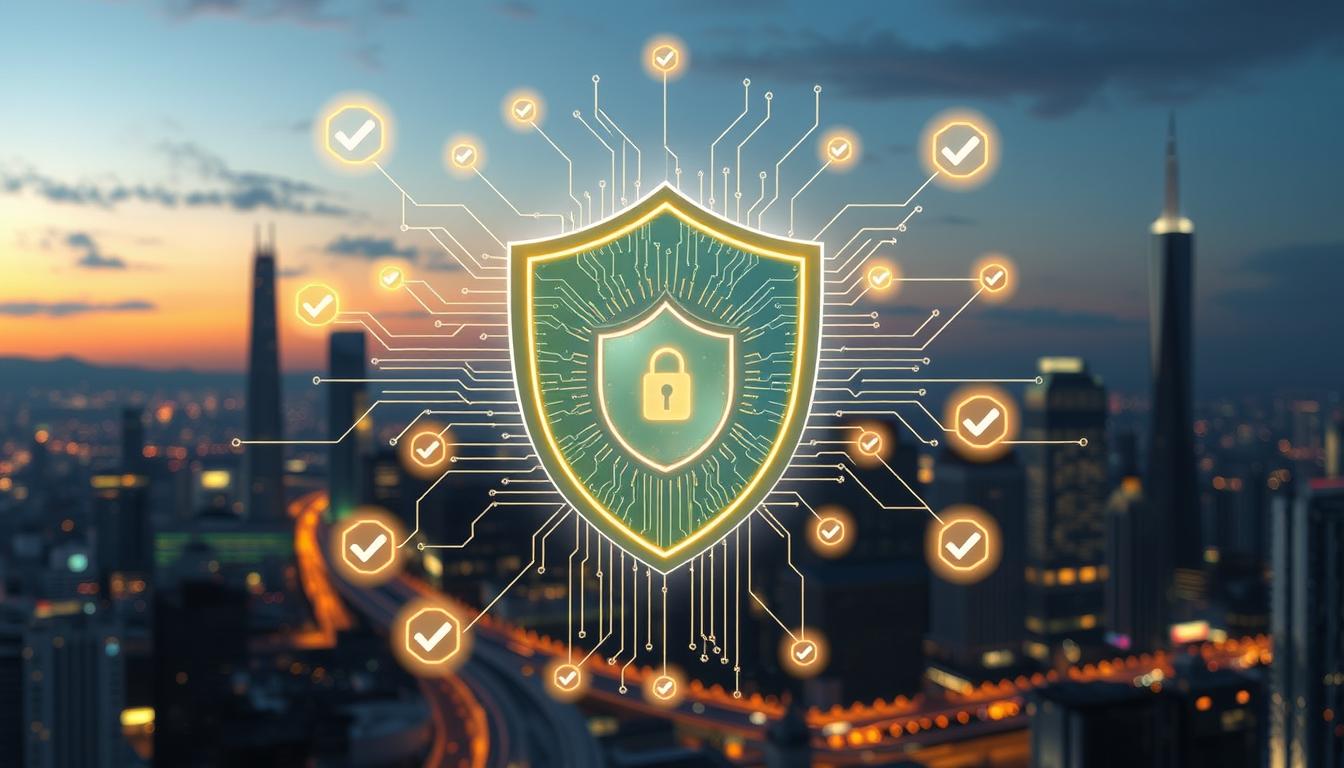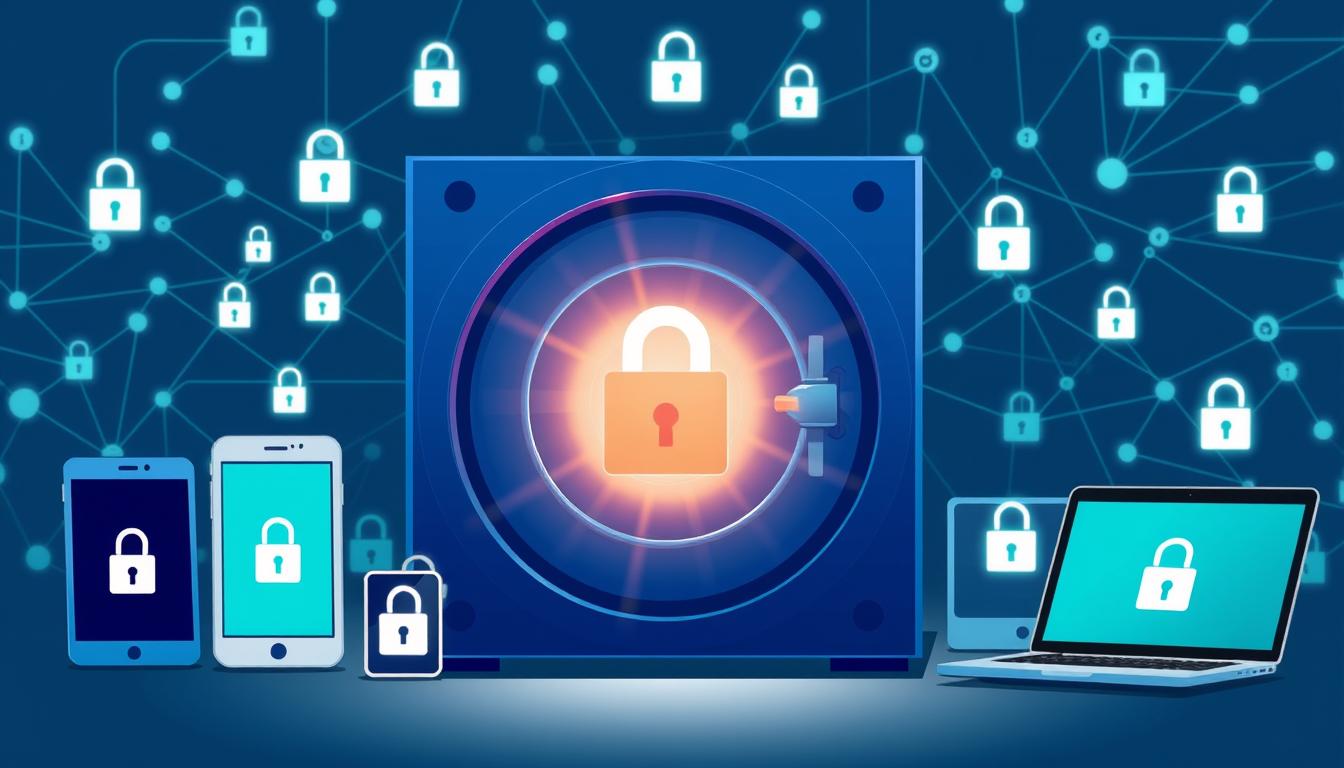Cyberattacks are seen as inevitable by 95% of cybersecurity experts, showing the need for strong defenses1. This fact stresses the importance of layering your cybersecurity defenses. By using network security layers and strategies, you can lower the risk of cyberattacks. For more on cybersecurity awareness, check out cybersecurity awareness tips.
About 80% of cyberattacks are automated, targeting anyone, not just the wealthy or famous1. To fight this, it’s key to have strong cybersecurity measures. This includes multi-layered security and regular checks. This way, you can keep your network safe from threats.
Using 2-Factor Authentication can cut down unauthorized access by up to 99.9% for online accounts1. This shows how important strong authentication is in your cybersecurity plan. By combining different security layers, you can greatly improve your protection against cyber threats.
Key Takeaways
- Layering your cybersecurity defenses is key to fighting cyber threats
- Using network security layers and strategies can lower the risk of cyberattacks
- Regular security checks and multi-factor authentication are vital for strong defense
- Cyberattacks are seen as unavoidable by 95% of cybersecurity experts, showing the need for strong defenses1
- Automated attacks make up about 80% of all cyberattacks, targeting anyone, not just the wealthy or famous1
- 2-Factor Authentication can reduce unauthorized access by up to 99.9% for online accounts1
Understanding the Fundamentals of Layering Your Cybersecurity Defenses
To build a strong cybersecurity plan, it’s key to know about layering defenses. This method uses many security controls to fight cyber threats. It makes a company’s cybersecurity stronger and lowers the chance of cyberattacks. In fact, 74% of companies face at least one cyberattack yearly, showing the need for a solid plan2.
Defense in depth is a big part of layered security. It uses different security tools like firewalls, intrusion detection systems, and encryption. These tools help a company respond better to cyber threats and lower the risk of attacks. For example, using multifactor authentication can stop up to 99.9% of automated attacks, making it very important2.
Some benefits of using many security layers include:
- Stronger protection against cyber threats
- Better incident response
- Less chance of successful cyberattacks
By using a defense-in-depth strategy, companies can lower the risk of big security breaches. In fact, companies that use this strategy are 30% less likely to face a major breach, showing how effective layered defenses are2.
Also, businesses that keep monitoring their systems find breaches 40% faster than those that don’t2. This shows how important continuous monitoring is in a multi-layered security setup. By combining different cybersecurity techniques, companies can make their defenses stronger and lower the risk of cyberattacks.
Essential Components of a Strong Security Foundation
A strong security foundation is key to fighting cyber threats. Using layered security solutions can greatly lower the chance of a cyber attack3. Firewalls, intrusion detection systems, and encryption are important. They block unwanted internet access, watch network traffic, and keep data safe from hackers.
Companies can use cyber defense strategies with many security layers. This can cut down breaches by up to 90% compared to just one layer3. Also, keeping software up to date and training employees can lower the risk of attacks by over 70%3.
Some key parts of a strong security foundation are:
- Firewalls and intrusion detection systems to prevent unauthorized access
- Encryption to protect sensitive data
- Regular software updates and patches to reduce vulnerability exploitation
- Employee training and awareness to prevent phishing attacks and other social engineering tactics
By adding these parts, companies can make their network security stronger. This helps lower the risk of cyber attacks4.
Building Your Network Security Architecture
Creating a strong network security architecture is key to fighting cyber threats. It involves setting up several network security layers to block unauthorized access and spot threats early. Firewalls and intrusion detection systems are vital for the network’s safety5. Yet, they must work together with other cybersecurity strategies for full protection.
Internal network segmentation is a big part of a solid security plan. It breaks the network into smaller parts to make it harder for attackers to get in. Using VLANs and ACLs helps with this. Also, tools like multifactor authentication (MFA) and SIEM systems are great for catching and handling threats5.
Having a strong network security architecture brings many benefits. It boosts protection against cyber threats, improves how well you can find and deal with threats, and lowers the chance of data breaches6.
- Improved protection against cyber threats
- Enhanced detection and response capabilities
- Reduced risk of data breaches and other security incidents
By investing in a solid network security architecture, companies can safeguard their data and keep their operations running smoothly6.
Advanced Security Layer Implementation Techniques
Using a multi-layered security approach is key to better cybersecurity. It helps fight off threats like phishing, malware, and insider attacks7. Small businesses are often targeted, with 43% of cyberattacks aimed at them7.
Encryption is a big part of advanced security. SSL/TLS and AES keep data safe from hackers8. Multi-factor authentication makes sure only the right people get into the network. Microsoft says MFA can block 99% of automated attacks8.
Security Information and Event Management (SIEM) systems are also vital. They watch for unauthorized access and alert to unusual activity7. Threat intelligence helps spot and stop cyber threats early7.
The benefits of layered security include:
- It makes systems more resilient, even if one layer is breached7
- It guards against many threats, like phishing and malware7
- It offers real-time monitoring to lower security breach risks7
By using a multi-layered security strategy, organizations can boost their cybersecurity. This involves encryption, authentication, and SIEM systems for strong defense7.
Real-time Monitoring and Threat Detection Systems
Implementing effective cyber defense strategies is key to fighting cyber threats fast. Recent data shows 60% of firms with real-time monitoring cut their response times9. This shows how vital strengthening network security defenses with top-notch tools is. Real-time systems are essential for spotting threats early and alerting teams to act quickly.
These systems use smart tech to scan network traffic for odd patterns. This helps spot security problems early. By using these tools, companies can boost their cyber defense strategies and get better at staying safe. For example, firms using AI and machine learning cut down on false alarms by 50%9.
Also, these systems help firms meet legal standards. Sadly, 70% of companies don’t follow GDPR because they don’t watch their networks closely enough9. With the right tools, companies can cut their response time by 40%9, saving them from big losses.
Real-time monitoring and threat detection systems offer many benefits:
- They make incident response faster
- They boost a company’s security
- They cut down on false alarms
- They help meet legal standards
By using these systems, companies can make their cyber defense strategies stronger. This helps them fight off new cyber threats. Real-time threat detection is a must for modern security. As threats grow, companies need to keep up with the latest tools and effective cyber defense strategies to stay safe10.
Maintaining and Updating Your Defense Layers
Regular security checks are key to keeping your defenses strong. They help find weak spots and improve your security11. This means adding layers to protect against different cyber threats. With solid cybersecurity strategies, you can make your network security layers stronger and lower the risk of breaches.
Training your employees is a big part of keeping your defenses up. It teaches them about cybersecurity best practices and how to spot phishing attacks11. This helps stop mistakes like falling for phishing or using weak passwords, which can weaken your security11. Also, having a strict password policy that requires updates and complexity helps a lot11.
Using layered security elements can also protect your network. This includes firewalls, network segmentation, and SIEM systems to catch and handle threats quickly11. By using these tools and strategies, you can lower the chance of attacks and lessen their damage.

Conclusion: Strengthening Your Security Posture Through Strategic Defense Layers
Protecting against cyber threats is key. Layered security solutions help a lot. Companies with many layers of security face a 40% lower chance of data breaches12.
Investing in defensive training is smart. It can cut down incident response times by up to 50%13.
A solid security base is vital. Regular checks, updates, and training for employees are musts. These steps can lower attack success by 70%13. SIEM systems can spot threats 30% faster than old security methods12.
Companies focusing on cyber defense can save up to 39% on data breach costs13. The need for cybersecurity pros is growing fast, by 31% from 2019 to 202913. A Defense in Depth strategy is best. It uses many layers to protect against threats14.
FAQ
What is the importance of layering your cybersecurity defenses in today’s digital landscape?
What are the key components of a strong security foundation for protecting against cyber threats?
How can organizations build a network security architecture to protect against cyber threats?
What are some advanced security layer implementation techniques for protecting against cyber threats?
Why is real-time monitoring and threat detection important for protecting against cyber threats?
How can organizations maintain and update their defense layers to protect against evolving cyber threats?
What are the benefits of implementing a multi-layered security approach for protecting against cyber threats?
Source Links
- Category: Cyber Awareness – https://www.drizgroup.com/driz_group_blog/category/cyber-awareness
- What Is Defense In Depth? Best Practices For Layered Security | Wiz – https://www.wiz.io/academy/defense-in-depth
- Defense in Depth: Layered Security Strategies – Blue Goat Cyber – https://bluegoatcyber.com/blog/defense-in-depth-layered-security-strategies/
- 7 LAYERS OF CYBER SECURITY YOU SHOULD KNOW | Bilginç IT Academy – https://bilginc.com/en/blog/7-layers-of-cyber-security-you-should-know-5933/
- Defense in Depth in Cybersecurity Architecture – https://medium.com/@tahirbalarabe2/defense-in-depth-in-cybersecurity-architecture-ba26e948757b
- Layered defense: Improving your network security – https://www.business.att.com/learn/articles/layered-defense-improving-your-network-security.html
- The Importance of Layered Cybersecurity Solutions – https://www.tripwire.com/state-of-security/importance-layered-cybersecurity-solutions
- The Layered Cybersecurity Defense Infographic – https://dotsecurity.com/insights/blog-layered-cybersecurity-defense
- Measuring the Significance of Network Monitoring for Cyber Defense – https://intervision.com/blog-measuring-the-significance-of-network-monitoring-for-cyber-defense/
- Role of Real-time Threat Detection in Modern Cybersecurity – https://www.cloud4c.com/blogs/complete-security-guide-real-time-threat-detection-and-response
- Strength in Layers: Why a Layered Approach to Security is Your Best Bet | Rippling – https://www.rippling.com/blog/why-a-layered-approach-to-security-is-your-best-bet
- Strengthening Cybersecurity- Part 3: Peeling Back the Layers of Protection | Insights | Elliott Davis – https://www.elliottdavis.com/insights/strengthening-cybersecurity-part-3-peeling-back-the-layers-of-protection
- Strengthening Your Cyber Defenses: The Critical Role of Defensive Training | OffSec – https://www.offsec.com/blog/defensive-cybersecurity-training/
- What is Defense in Depth (layered security)? | Future Processing – https://www.future-processing.com/blog/defense-in-depth-cybersecurity/










